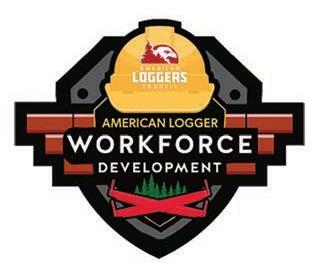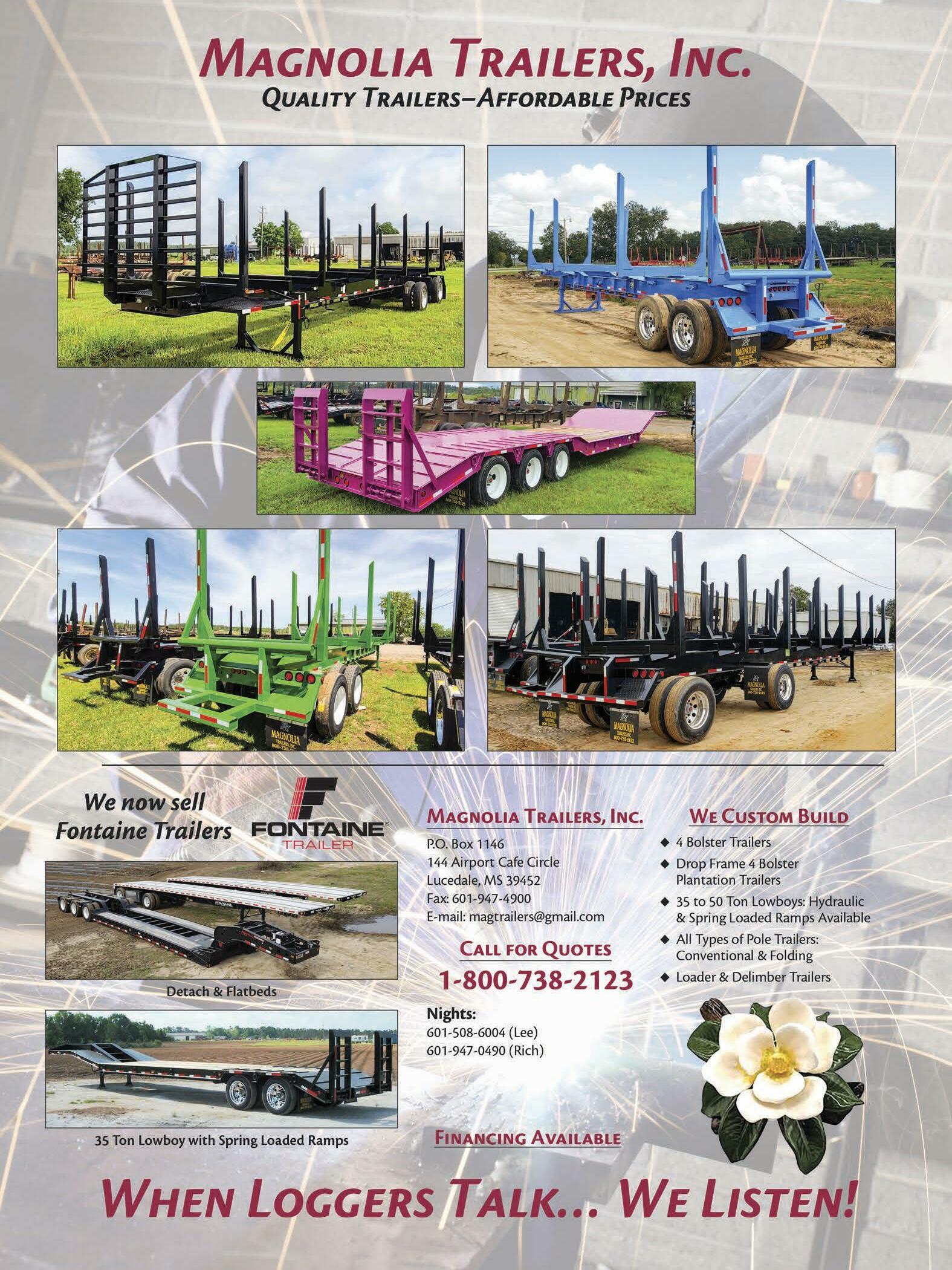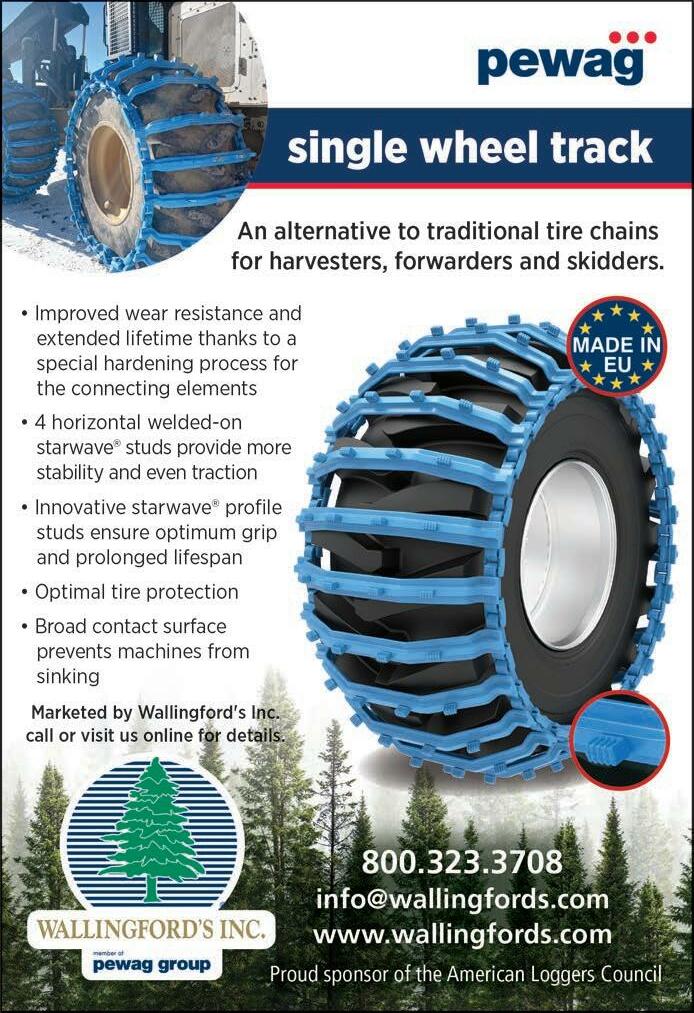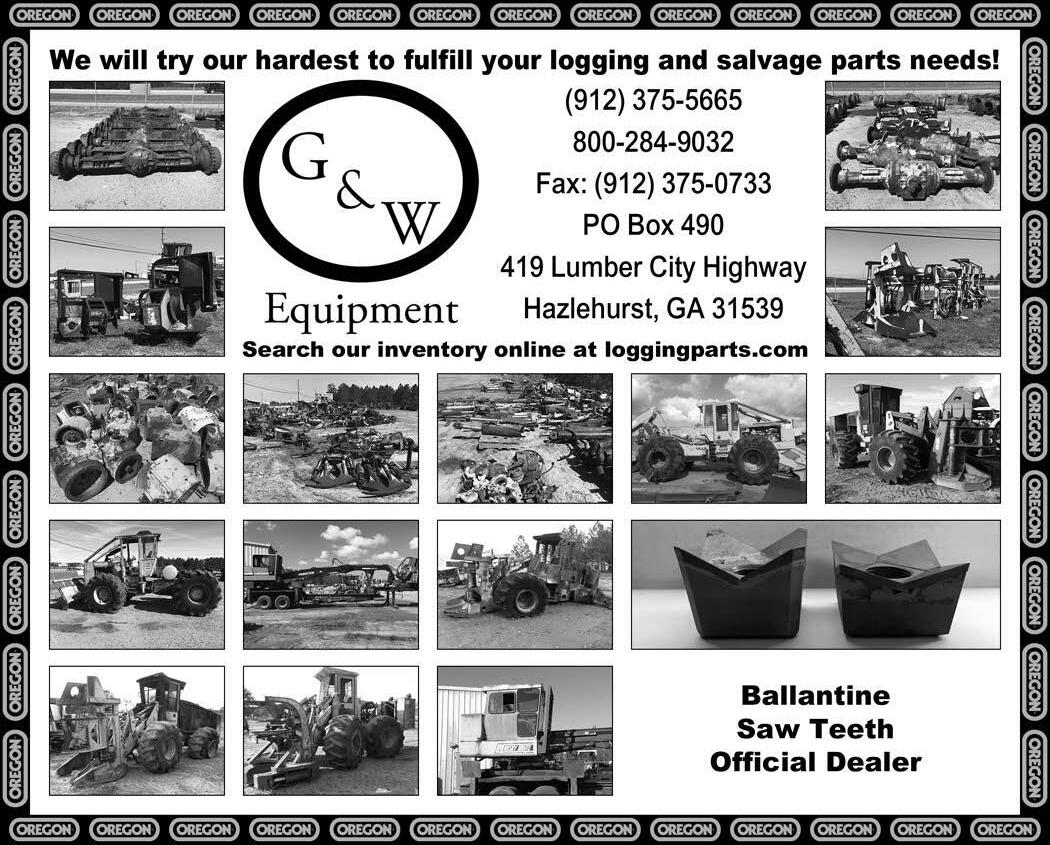
10 minute read
Industry News Roundup
As We See It: Logging Workforce Development
By Scott Dane
The pieces for workforce development have been identified, but before they can be put together, the elephant in the room must be acknowledged. Regardless of training programs (and there are numerous good ones), the industry needs to be competitive to attract workers.
The existing logging and trucking workforce is aging out at a rate that exceeds those entering the workforce pipeline. This trend will be gin to compromise production in the next five to ten years, if not sooner. This issue is further compounded by the fact that the average logging company owner is in their upper 50s. Unless they have a succession plan, such as passing on the com pany to the next generation – and many do not – then these companies will exercise their retirement plan: sell their iron (equipment) and discontinue operations. American Loggers Council member Jim Houdequin, CEO of Lyme Timber Co., testified recently in the Senate Committee on Energy and Natural Resources. He stated, “Em ployment in logging has de clined by 41% from 86,000 in 1990 to under 50,000 today, a decline of 2% per year. However, logging output has remained nearly flat, so re ductions in employment have been almost completely offset by increases in productivity.” Houdequin also described the challenges to workforce recruitment in the logging sector, including low profit margins and wages, physically demanding work, safety challenges, and limited technical training. So, let’s get back to the elephant in the room. The timber industry is going to remain challenged in its efforts to retain and recruit the work force necessary for sustainability if it is not competitive— competitive in wages, benefits, working conditions, and stability. In many instances, Starbucks, fast food chains and big box stores offer comparable wages and better benefits than entry-level logging jobs. What determines the wage scale and benefits within the timber industry? The amount that logging companies get paid for the wood they deliver. Most logging companies operate on a 3% profit margin, making it prohibitive, if not impossible, to increase wages or offer competitive benefits, so they offer what they can afford and hope for the best. “I believe the markets for logging services – principally land owners and mills – are beginning to address profit margins and logger compensation, but many of the other challenges cannot be ad dress ed by the private sector alone,” Houdequinin also said in his testimony cited above. With that premise in mind, the public and private sectors are waking up to the fact that the workforce challenges represent a current and pending threat to the timber and

Dane



forest products industries.
Currently, the typical training pro gram in much of the industry consists of a couple of days of best management practices and other topics, then a few hours of instruction on a piece of equipment followed by on-the-job training. With the complexity, technology and cost of today’s logging equipment, that practice is no longer a viable nor a productive process. Training programs such as the Heavy Equipment and Logging Operations (HELO) program at Shasta Community College in California; the Maine Mechanized Logging Operations Program, administered by Northern Maine Community College; Mississippi’s Logging Equipment Operator Academy, administered through Hinds Community College; and others across the country are beginning to pump trained and productive work ers into the employment pipe line. Productivity is the key to getting MORE (production) out of LESS (workers).
Promoting the timber industry’s value, opportunities, and the training process is critical to attracting new workers. The American Loggers Council (ALC) has recently received a $100,000 grant as part of a $250,000 Public Image and Workforce Development grant to im prove the public understanding of the timber industry while recruiting new mechanized logging equipment operators. ALC will be working with the state associations to promote their programs, other industry stakeholders to support this initiative, and public and pri vate partnerships to educate the public. Additionally, ALC has been working with the federal government to establish training and investment programs to support the future of the timber in dustry.
The Senate Committee on Energy and Natural Resources, chaired by Senator Joe Manchin (D-West Virginia) and with ranking mem ber John Barrasso (R-Wyom ing), has included three provisions in the bill introduced in September that supports state training programs, onthe-job training, and low-interest loan guarantees for the purchase of mechanized logging equipment. See the official language here:
In summary, the first step in solving a problem is acknowledging there is a problem. Based on the facts of the aging workforce, the over all re duction in employment within the logging sector, and the lack of new entry-level workers com ing into the timber industry, it is clear that workforce shortages will negatively im pact timber harvest capacity if they are not ad dressed. The second step is developing a solution. Workforce development programs at the state levels, federal government support through legislation and public awareness/pro motion will collectively increase the opportunities to recruit and train new mechanized logging equipment operators.
The third step in addressing the workforce development threat and challenges is the competitiveness of the timber industry with refer-

TITLE III – WORKFORCE SEC. 301. LOGGING WORKFORCE. (a) TRAINING. — (1) INTERSTATE TRAINING PROGRAMS. — The Secretary of Agriculture, acting through the Chief of the Forest Service, shall work with States to develop a universal, tiered program to train persons to enter the logging workforce. (2) ON-THE-JOB TRAINING.—The Secretary concerned shall examine potential ways to facilitate apprenticeship training to increase knowledge and skills in an emerging logging workforce. (b) MODERNIZING MACHINERY. – Using funds made available under section 40804(b)(3) of the Infrastructure Investment and Jobs Act (16 U.S.C. 6592a(b)(3)), the Secretary of Agriculture determines to be necessary, for the acquisition of mechanized machinery for decreasing injuries in the logging workforce.
ence to comparable industries. This final step in solving the workforce development issue is solely up to the en tities that set the rate paid for delivered timber. These entities, the buyers, can invest in the workforce for to day and tomorrow. They can en sure the sustainability of the supply chain. They can support the extension of the same level of compensation and benefits as they do for mill workers and other vendors by working with their suppliers to understand their costs.
The pieces to solving the workforce development puzzle are here. The remaining question is whether the players are going to fit the pieces together to safeguard an economically productive wood products in dustry. The status quo, in the end, I’m afraid, is not sustainable for anyone.
Scott Dane is Executive Director of the American Loggers Council. ALC is a 501(c)(6) trade association representing the interests of timber harvesting and timber hauling businesses across the United States. For more information visit www.amloggers.com.
Northeast TX Receives Heavy Timber Damage
A series of tornadoes that struck northeast Texas in early November damaged timber on more than 10,000 acres; the timber was worth an estimated $13 million.
Storms that tracked across north Texas on November 4 resulted in seven tornadoes, five of which im pacted timberland in Bowie, Cass, Henderson, Morris and Red River counties, according to a Texas A&M Forest Service assessment of the damage. One person died as a result of the storm in Morris County.
The damage assessment used forest inventory data collected by Texas A&M Forest Service for esters and technicians as part of the Forest In ventory and Analysis (FIA) program. The data, including forest health, tree numbers, size and condition, was used along with satellite imagery from before and after the storms to estimate damage to timber.
Damaged trees were uprooted, snapped off below the crown or leaning significantly. Most of the damage to timber was on private property.
Damage was estimated for sawtimber—trees at least 9 in. in diameter at breast height; and pole timber—trees smaller than sawtimber but at least 5 in. in diameter at breast height. The value was determined using the most recent Texas Timber Price Trends report.
In Bowie County, an EF-2 tornado with peak winds around 125 MPH stretched for 15.7 miles and was 1,200 yards across at its widest point. The tornado damaged 2,279 acres of timber: 624 acres of pine forest, 1,327 acres of hardwood forest and 328 acres of mixed pine-hardwood forest. The total value of damaged timber in the county is estimated at $2.7 million.
In Cass County, an EF-1 tornado with peak wind speeds of 110 MPH damaged 3,250 acres of timber along its path of more than 20 miles. The damage included nearly 1,626 acres of pine forest, 1,149 acres of hardwood forest and 476 acres of mixed forest. The total value of damaged timber in the county is estimated at $4.1 million.
Damage in Henderson County was linked to an EF-2 tornado with estimated peak winds of 115 MPH. That tornado tracked more than 16 miles and damaged 194 acres of predominantly hardwood forest with an estimated value of $235,120.
The tornado in Morris County, an EF-2 with estimated peak winds of 125 MPH, tracked 16.9 miles and damaged 1,216 acres: 384 acres of pine forest, 645 acres of hardwood forest and 187 acres of mixed forest, with an estimated timber value of $2.1 million.
In Red River County, an EF-3 tornado with estimated top winds of 150 MPH cut a half-mile path at its widest point and had a 58-mile track of damage, stretching into Ok lahoma. The tornado damaged 3,606 acres of timber—816 acres of pine forest, 2,217 acres of hardwood forest and 573 acres of mixed forest—worth an estimated $3.9 million.
American Truckers Cite Fuel Prices, Drivers
The American Transportation Research Institute (ATRI), recently released its 18th annual top industry issues report, identifying the leading industry concerns including fuel prices, the driver shortage, truck park ing, driver compensation, the economy and for the first time, speed limiters.
According to American Trucking Assn. Chairman Harold Sumerford of J&M Tank Lines in Birmingham, Ala., “High fuel prices and finding drivers were two of our industry’s biggest challenges,” and those issues were made more difficult by the economy.
In a year that saw record high fuel costs, fuel prices were ranked as the top industry concern, replacing the driver shortage, which had been the number one issue for five years in a row. In 2022, the driver shortage was the second-ranked issue, followed by the lack of available truck parking. Rounding out the top five this year were driver compensation and the economy.
With the release earlier this year of the Federal Motor Carrier Safety Administration’s Notice of Intent to enter into a speed limiter rule making in 2023, speed limiters ranked in the top ten this year for the first time, coming in ninth overall and fifth among commercial driver re spondents. More than 4,200 trucking industry stakeholders participated in this year’s ATRI survey, in cluding motor carriers, truck drivers, industry suppliers, driver trainers, law enforcement, and others.
Stihl Plans Expansion At Virginia Beach
Stihl plans to invest $49 million to expand its chain saw guide bar manufacturing facility in Virginia Beach, Va. The expansion will add 26,000 sq. ft. of space to an existing building, totaling 86,000 sq. ft. upon completion. The project is also expected to create 15 jobs with an average annual wage of $60,000 to $100,000.
“For nearly 50 years, the City of Virginia Beach has created an ideal environment for Stihl to continue to grow our business and offer meaningful careers to over 2,500 current employees in Hampton Roads,” says Terry Horan, President of Stihl Inc. “We are incredibly proud to be able to continue to expand our Virginia Beach-based manufacturing operations to fulfill the increased demands of our more than 10,000 loyal Stihl dealers nationwide and their customers.”
Virginia Beach Development Authority (VBDA) voted to award Stihl an Economic Development Incentive Program (EDIP) grant of $500,000 for the expansion based on job creation and retention, plus capital investment estimated at $49 million. In addition to increasing its footprint in Virginia Beach, Stihl plans to invest in state-of-the-art equipment and add highly skilled positions to its team, including maintenance mechatronic technicians, process engineers, tool and die makers, project coordinators, and machine operators. The new project will allow for a third chain saw guide bar production line to be added at 825 London Bridge Road, increasing production capacity. Currently, most chain saw guide bar production takes place at other Stihl locations overseas, but this expansion lays the groundwork for additional manufacturing activity to be moved to the company’s Virginia Beach location.






